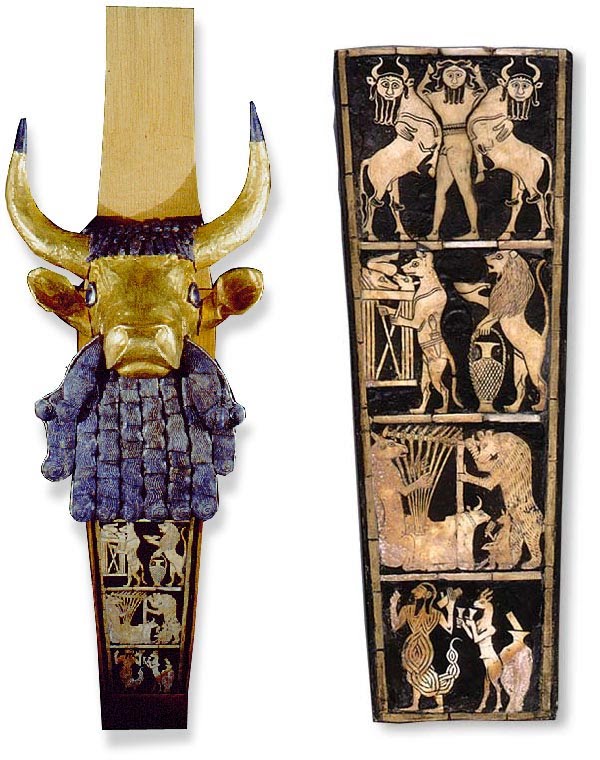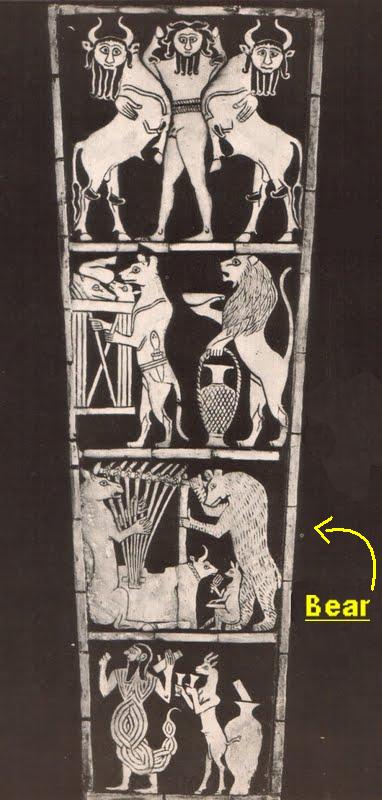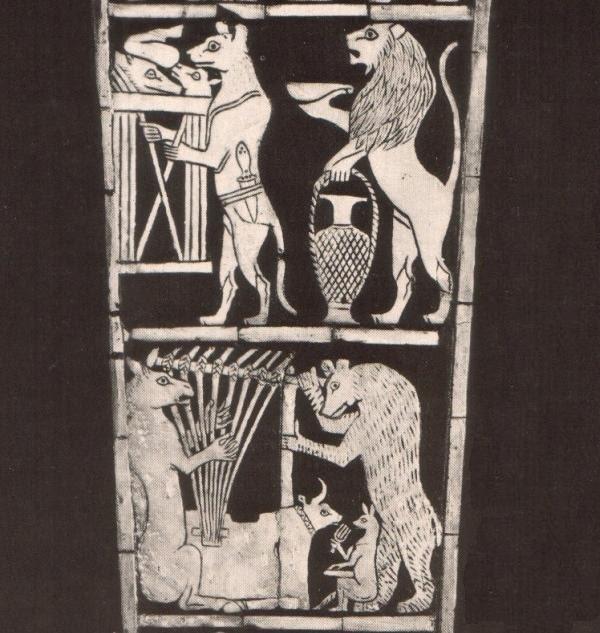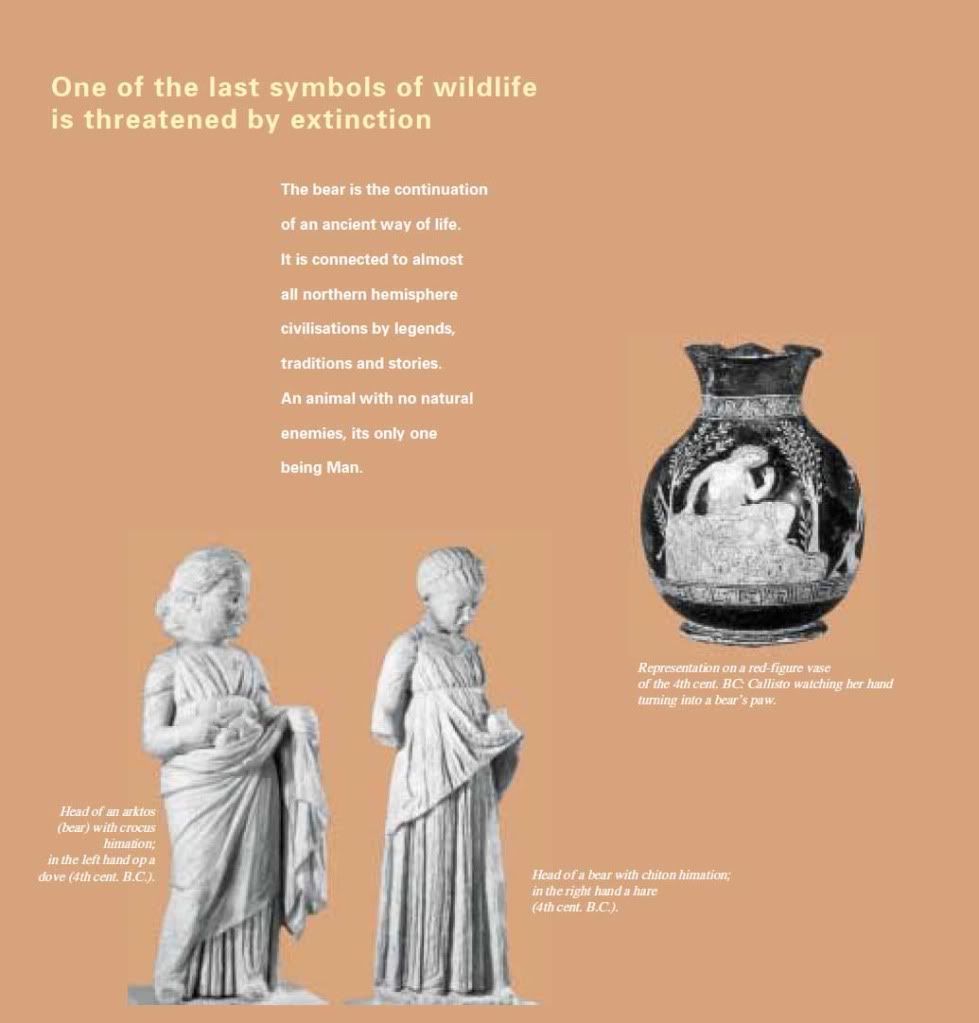|
|
Post by sarus on Sept 30, 2011 21:26:16 GMT -9
The Great Lyre of Ur Lyre with Bearded Bull's Head and Inlaid Panel, Royal Cemetery, Ur, southern Iraq, Early Dynastic III, 2550-2450 BCE, Wood, lapis lazuli, gold, silver, shell, bitumen, H. 35.6 cm. Penn Museum. ▬▬▬▬▬▬▬▬▬▬  Detail of the inlay panel of the lyre. According to the Penn Museum, "The front panel of the lyre tells the story of the funeral ritual itself. At the top, the nude hero grapples with two rampant human-headed bulls, representing royal control over nature. Beneath are three scenes that show the ritual with otherworldly actors. A hyena carries butchered meat on a table. Behind him is a lion, holding a jar and a pouring vessel identical to ones found in the graves. The third register depicts music-making: an equid (an ass or onager) plays a lyre while a bear supports it, nearby a small animal (hare?) shakes a rattle. The lyre depicted is similar to the very lyre to which it was attached. On the bottom is the last stage of the ritual, where the deceased meets the scorpion man, the guardian of the entrance to the underworld."▬▬▬▬▬▬▬▬▬▬ Detail For additional informations:sumerianshakespeare.com/509245/499545.htmlwww.penn.museum/sites/iraq/?page_id=58#www.historywiz.com/galleries/sumerianbull-lyre.html For additional informations:sumerianshakespeare.com/509245/499545.htmlwww.penn.museum/sites/iraq/?page_id=58#www.historywiz.com/galleries/sumerianbull-lyre.html
|
|
|
|
Post by grrraaahhh on Nov 15, 2011 11:37:54 GMT -9
Ancient Greece  OPA!!! ;D
|
|
|
|
Post by grrraaahhh on Nov 23, 2011 20:18:44 GMT -9
|
|
|
|
Post by sarus on Jan 7, 2012 8:39:27 GMT -9
Mosaic of Orpheus (Zaragoza, Spain)  Leopard, brown bear, tigress and lion.An example of the exquisite decorative taste and wealth of high society in the ancient Caesar Augusta city (Saragossa). Leopard, brown bear, tigress and lion.An example of the exquisite decorative taste and wealth of high society in the ancient Caesar Augusta city (Saragossa).This large mosaic presided over the flooring of a triclinium, or main room, of an important domus in Cesaraugusta (Zaragoza, Spain). The different coloured tesserae sets are sublimely laid in the mosaic, favouring exuberant iconography of the mythical figure of Orpheus playing a zither. It has been dated between the start of the 2nd and 3rd centuries A.D. :::::::::::::::::::::::::::::::::::::::::::::::::::::::::::::::::::::::::::::::::::::::::::::::::::::::::::
:::::::::::::::::::::::::::::::::::::::::::::::::::::::::::::::::::::::::::::::::::::::::::::::::::::::::::es.wikipedia.org/wiki/Casa_de_orfeowww.spainisculture.com/en/obras_de_excelencia/mosaico_de_orfeo.html:::::::::::::::::::::::::::::::::::::::::::::::::::::::::::::::::::::::::::::::::::::::::::::::::::::::::::
:::::::::::::::::::::::::::::::::::::::::::::::::::::::::::::::::::::::::::::::::::::::::::::::::::::::::::
|
|
|
|
Post by grrraaahhh on Feb 1, 2012 19:20:44 GMT -9
URSUS MAJOR W. W. Newell. The Bear in Hellenic Astral Mythology. The Journal of American Folklore, Vol. 13, No. 49 (Apr. - Jun., 1900), pp. 147-149. PDF LINK: www.jstor.org/stable/533806 |
|
|
|
Post by grrraaahhh on Dec 29, 2012 10:43:28 GMT -9
|
|
|
|
Post by warsaw on Apr 13, 2014 7:36:39 GMT -9
Bestiarii (beast fighters) with whips try to distract a bear mauling a fallen gladiator. From a floor mosaic of the second or third century AD, Nennig. (VRoma: Barbara McManus)  www.the-romans.co.uk/games.htm www.the-romans.co.uk/games.htm |
|
|
|
Post by sarus on Jan 31, 2020 21:52:27 GMT -9
¨  Wall painting in the Tomb of Rekhmire at Thebes/ Egypt, The tribute of Syria: elephant, bear, tusk and copper ingot (from De Garis Davies 1935, Pl. XII) "Rekhmire was an ancient Egyptian noble and official of the 18th dynasty who served as "Governor of the Town" (Thebes) and Vizier during the reigns of Thutmosis III and Amenhotep II ( Wikipedia)." .
|
|
|
|
Post by sarus on Jun 9, 2023 0:07:43 GMT -9
|
|
|
|
Post by sarus on Jun 9, 2023 0:56:46 GMT -9
|
|
|
|
Post by sarus on Jun 9, 2023 2:11:55 GMT -9
|
|